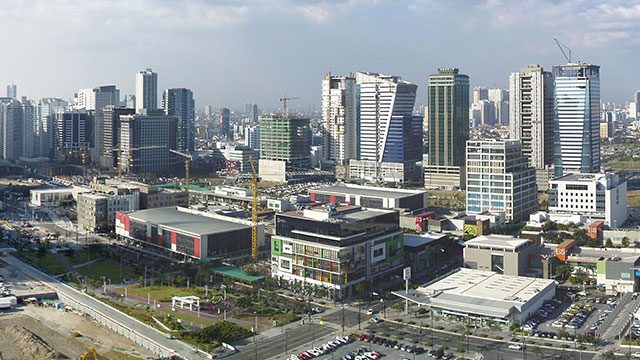SUMMARY
This is AI generated summarization, which may have errors. For context, always refer to the full article.

MANILA, Philippines – As most locators, particularly in business process outsourcing, prefer central business districts (CBDs) in Metro Manila as sites, it is not surprising that the National Capital Region posted the second highest increase in prime office space occupancy costs among 126 office markets worldwide.
This is based on the results of CBRE’s bi-annual Global Prime Office Occupancy Cost survey released Thursday, February 12.
The survey measures and compares office occupancy costs in 126 markets across the world. In its latest findings, over half of 126 office markets saw annual increases in prime occupancy costs.
From these markets, 13 saw increases of at least 10%, led by Dublin, Manila, and Seattle (sub-urban).
Manila posted a 20.7% annual increase in prime office space occupancy costs as of the third quarter of 2014.
Dublin registered 34.9% annual increase in prime office space occupancy costs while Seattle (sub-urban) posted 20.5% for the same period.
Occupancy costs in key Southeast Asian markets leaped as increased demand from technology, media, and telecommunications companies competed with traditional sectors for the limited supply of prime space, the CBRE study said.
With the exception of Pudong in Shanghai, costs in China were essentially stable over the past year.
NCR as a preferred location
Many still opt to set up in NCR, citing well-planned development, Jose Mari Mercado, president and CEO of the IT and Business Process Association of the Philippines (IBPAP) said in November.
Real estate experts cited Taguig’s Bonifacio Global City (BGC) as a preferred location, which its growing supply of office space and well-developed infrastructure.
Another CBD being eyed as the emerging BPO hub: Vertis North behind Ayala’s TriNoma mall in Quezon City. The project is one of the 6 growth centers unveiled by the Ayala group this month.
In another survey, Metro Manila’s ranking in Asia Pacific’s prospective cities for investment slipped 4 notches from a record fourth place in 2014.
According to the results of the Emerging Trends in Real Estate Asia Pacific 2015 survey released in January 8, Metro Manila’s fall from 4th to 8th spot probably reflects investors’ wariness in the wake of impending rise in US interest rates.
Manila stood 4th in the 2014 survey results, only behind Tokyo, Seoul, and Jakarta.
Regulations that restrict foreign land ownership have dampened interest in development, as published by PricewaterhouseCoopers and Urban Land Institute.
The Philippine Constitution bars foreign investors from owning more than 40% of land and owning corporations in the country.
Most expensive markets
The CBRE study also revealed that Asia dominated the top 10 list of most expensive markets:
- London (West End)
- Hong Kong (Central)
- Beijing (Finance Street)
- Beijing (CBD)
- Moscow
- New Delhi (Connaught Place-CBD)
- Hong Kong (West Kowloon)
- London City
- Tokyo (Marunouchi Otemachi)
- Shanghai (Pudong)
Paris dropped out of the top 10 most expensive list, falling to 13th spot.
Regionally, the Americas registered a 4.1% year-on-year change in occupancy cost while Europe registered 0.3% and Asia Pacific, 2.8%.
The increase in occupancy rates can be attributed to the recovery and positive outlook on the economies of the markets, CBRE said.
Demand likewise remains high with global, multinational organizations looking for highest-grade, prime-located properties that will attract top talent. These companies are willing to “pay the price” for their expansions, the study noted.
Factors for growth
Asia Pacific is still seen as a key region for business growth and expansion in 2015, according to CBRE.
The increase in prime office occupancy costs, at a 2.5% annual rate for the 12 months ending third quarter 2014, mirrors the gradual, multi-speed recovery of the global economy, said Rick Santos, CBRE Philippines chairman, founder, and CEO.
“As recovery continues, the demand and power to expand will likewise increase. When this happens, Asia Pacific, with highlight to the Philippines, will benefit greatly,” Santos said.
The unemployment rate in Asia Pacific markets is low and will range from 1% to 7 % in 2015, CBRE added.
Job growth in the coming year will be above the 5-year average in most markets. Southeast Asian markets will experience the strongest growth, including the Philippines and Malaysia, which are projected to see growth of 4.3% and 2.4% respectively.
“Cost efficiency and a professional labor pool remain as the top drivers for multinationals in expanding their operations within or outside their home countries, Santos said.
“As with any other industry, there’s a price for this and gladly, these companies are willing to pay for it,” Santos pointed out. – Rappler.com
Add a comment
How does this make you feel?
There are no comments yet. Add your comment to start the conversation.